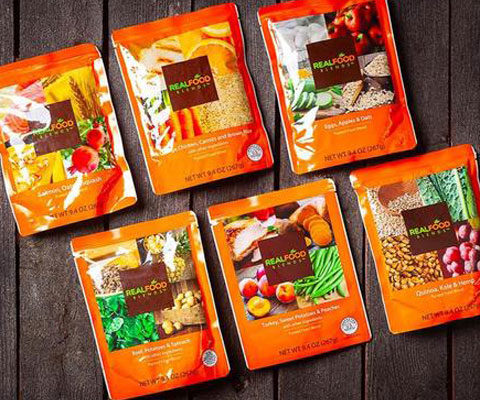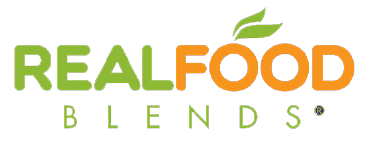
Is Real Food Right For You?
This is a special guest blog post by Lara Field, MS, RD, CSP
If you’ve only ever used formula in your feeding tube, the idea of transitioning to real food can seem overwhelming. When deciding whether to add real food to your tube-fed diet, whether you’re blending from home or using Real Food Blends, there are really only a few things to consider. For many people, real food is a very real possibility. Make sure to consult your medical team before making any change to your tube feeding regimen, but if you’re looking to start incorporating real food, consider the following:
 Age
Age
Real food, including Real Food Blends meals, is not limited to only children or only adults. Just like for oral eaters, infants under the age of 1 should stick to breastmilk and formula, but once a child hits their first birthday, parents can begin transitioning to real food. (Check out our past guest blog post from Weronika Brill RN with tips for transitioning a 1-year-old tubie to a blended diet.) Breastmilk/formula provide essential nutrition for babies under 1 year of age, and solid foods are supposed to be complementary, so we suggest waiting until your child depends on food for 100% of their nutrition. Adults of any age, especially those who previously ate regular food, can consider real food through their feeding tubes.
Why a Feeding Tube?
The original reason for the feeding tube being placed is the most important thing to consider when looking into real food. If the tube was placed because of an inability to consume enough calories orally, or to safely get food into the stomach (i.e. risk of aspiration), then the digestive system should still be working. If the stomach and digestive tract work as they should, real food can – and many would say should – be considered.
However, if the tube was placed due to malabsorption or digestive issues, you may be unable to properly digest or absorb real food and require a specialized formula. There’s no firm evidence or anyone tracking this to our knowledge, but most people we meet that have feeding tubes usually have them because of the risk of aspiration or an inability to get enough calories orally – not because their stomach wasn’t working! These “tubies” are excellent candidates to continue to benefit from whole food nutrition.
It’s important to look at the original reason for the tube being placed. I have seen many patients throughout my career that end up on broken-down or specialized formulas after tube-feedings were introduced – this is more likely a sign of formula intolerance, not a sudden digestive issue if the patient has been eating regular food their whole life.
G-Tube vs J-Tube
Although real food can be used with a J-tube, many tubies and medical professionals can be hesitant to move away from formula in these cases. As discussed above, what should be considered first is why the J-tube was placed and why G-tube feeds failed. It’s entirely possible that the failure of G-tube feedings in some patients is due to formula intolerance, not a digestive issue that necessitates J-tube feedings. With medical approval, blended foods and Real Food Blends meals can be used with a J-tube, but extra caution should be taken to make sure the blends are thin enough and strained of any extra food particles. (For G-tubes, Real Food Blends meals are tested to work with 14f or larger tubes.)
Why Real Food?
Aside from common sense (hello, fruits and veggies!), there is a growing body of research showing that real food through feeding tubes can improve many typical symptoms of formula intolerance, including acid reflux, vomiting, nausea, constipation, diarrhea, weight loss/lack of weight gain, and/or requiring overnight or continuous feeding. Conversely, there are no documented, clinical studies showing that enteral formula is preferable over a whole food for long term use – wouldn’t we all be drinking enteral formula if that was the case!? Using real food also allows those with feeding tubes to benefit from having a varied diet with a wide variety of nutrients (just like I recommend to oral eaters!) in a way that is impossible with commercial formula (learn more about the importance of nutritional variety).
If you or your loved one with a feeding tube meet the simple requirements described above, then real food is something you should be discussing with your doctors.

Lara Field, MS, RD, CSP, is an accomplished Registered Dietitian and the founder of FEED (Forming Early Eating Decisions), a nutritional consultancy based in Chicago. Mrs. Field is an advisor to Real Food Blends and has extensive clinic and internship experience at top ranked institutions including Lurie Children’s Hospital, University of Chicago Comer Children’s Hospital, Rush University Medical Center, and Johns Hopkins.







My husband has a Gtube and was initially on various enteral canned formulas. About 30-45 min after a meal, he would be dizzy, shaking and not able to walk well. He also had much diarrhea and was losing weight continually. After lots of research, I began introducing blenderized foods slowly, first with his formula and using sweet potatoes, then applesauce then with success, whole meals. He is slowly gaining weight and has no dizziness or shaking. My problem is that when I tell doctors this, they look at me like I am doing something wrong. I have asked for tests to show he he cannot tolerate formula and they keep doing tests for diabetes, which he does not have and obviously does not show up. What blood work will show an intolerance to the high carb high sugar formulas??? Whenever he has to be in the hospital, they place him on formula and he looses more weight and feels terrible. I get him home and start the blenderized foods again, he gains weight, energy and feels better. HELP!!!
Hi Kim! So glad to hear your husband is doing better on a blended diet. Our dietitian will be reaching out to you shortly with some advice for how to document his intolerance to formula with his doctors.